| New World of Awareness Brought
About by Evolution of VR |
|
"The 5th State of the Art Technologies in Expression Association
/ Latest Technology Art Session" was held in the former half of the
afternoon session on Day2. First of all, Akira Hasegawa, Chairman of
The State of the Art Technologies in Expression Association gave an
address. As one year had passed since he took office as Chairman, he
talked about how he actually felt about the rapid progress in the
technologies of this field. For example, it is sometimes hard to
distinguish whether something one sees is real or virtual because a
plenty of technologies for virtual reality has come in. He even
considers that it may be virtual that human beings live, referring
to money, languages, and time. In this sense, all the information is
managed by time, and moreover, "assembly of past information is
information", and "(we are) (equal to) living in the past society",
"(which has been) performed for a long time", in one way of
thinking. In his opinion, as high-speed communication measures
symbolized by computers or 5G progress, they may be aiming to become
"tools to know oneself independent of organizations" in the future.
Based on such ideas, he reviewed the activities of State of the Art
Technologies Expression Association so far, such as Expression
Technology Test (town planning/Information and Communications
Technology for Construction) as well as publication of guidebooks.
|
|
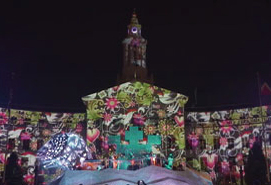 |
Digital Kakejiku (DKFORUM) produced by Mr.
Akira
Hasegawa, Chairman of State of the Art
Technologies in
Expression Association at
Biennial of The Americas Denver
2019 |
|
Subsequently, Mr. Katsura Hattori, a Journalist gave a special lecture
entitled "What is the information environment in next generation that VR
is aiming at?" He introduced his involvement with VR dating back to the
days when the first VR product (communication device) was released in
1989, and the difference in the environment of using VR between those days
and the present. Then, he developed his speech covering the following
items: views and actions about VR in the United States and Japan in around
1990 (which was translated as "artificial reality" at that time and the
translation changed to various terms), simulators and games that reflect
military needs etc. after the dawn of computers and cold war era that
further date back, actions on technologies in expression (except VR)
similar to present VR application in the fields of space development and
medical care and so on, subsequent evolution of VR application
technologies including not only the visual sense but also the touch sense
as well as diversification of applied fields, and widening of contents
linked with advanced ICT such as 4K resolution or 5G. Furthermore, he
mentioned such examples as the world where the ecosystem with high
resolution autonomously moves in VR, AR made by adding the actual world to
VR, and a usage of VR to make various environments perfect simulation
spaces (parallel to the actual world) by VR, in which trial and
improvement of things such as automated driving are repeated (the mirror
world). He presented a view that it is VR that takes back an individual
point of view in the world of information like this (or becomes a metaphor
for how oneself moves as one places him- or herself in the center of the
world). In addition, VR is what computers have evolved into, and it is
more important for it including AI to be "useful" in the future.
Therefore, if VR allows the users to get not only efficiency and profit
but also awareness as a new person, a world greatly different from the one
in the past should be created.
(This part is written by Takashi Ikeno)
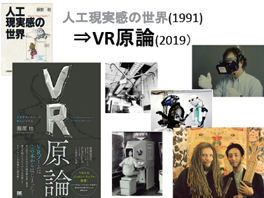 |
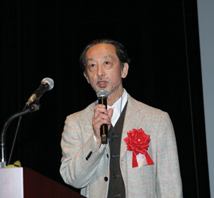 |
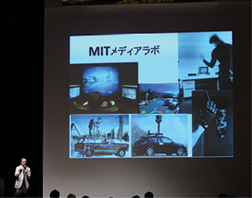 |
|
Mr. Katsura Hattori, Jounalist |
|
Next, we held that award ceremony for The 3rd Hagura Award. Many
high-level works are submitted this year, and Hagura Award was given to 3
works, FORUM8 Award to 1 work, Encouragement Award to 3 works, and new
Nomination Award to 3 works.
One of the Hagura Award work is 'Kanazawa5G gate 2019 "Mimassi"'
by Kanazawa Institute of Technology Regional revitalization / DK art café
project. The committee highly evaluated their first trial utilizing 5G
technology for events that citizens can participate by the cooperation
between Kanazawa city, corporations, and universities.
Hagura Award is also given to "Interactive Projection Mapping" by
Faculty of Information Science, Aichi Institute of Technology / Sony
Corporation / NTT DOCOMO, Inc. Carps are swimming according to humans
motion inside the images displayed on the side of movable cart and floor
projection image expressing a pond. The audience paid attention to this
interactive system.
The last Hagura Award is given to "WV Sphere 5.2" by WONDER VISION
TECHNO LABORATORY. This large portable sphere screen system is used at
events all over Japan and several people share a variety of space
experience at the same time.
ONI's "Sounds and colors of life" that won the FORUM8 Award is an
installation work. Stereo sound, electronic live music, and soap bubbles
are controlled by programming and create the fantastic and friendly world.
"Melody Slot Machine" by RIKEN and Waseda University, "3D Noh" by Meiji
University, and "360 degree 3D ceater" by Solidray Co., Ltd. won the
Encouragement Award. The Nomination Award was given to "Space - Star
experience" by School of media art in Tokyo, Takarazuka University,
"Interactive 360 degree table top type 3D image display technology" by
Service Evolution Laboratories / Hokkaido University, and "MR Rube
Goldberg machine" by College of Information Science and Engineering,
Ritsumeikan University.
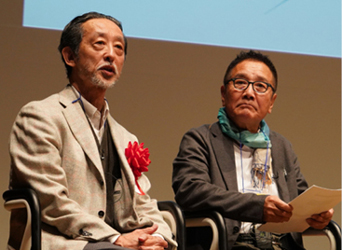 |
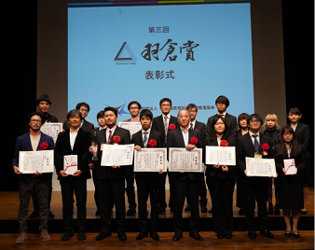 |
| Comment on Hagura Award: Mr. Hattori (left), Mr.
Hasegawa (right) |
Award winners |
|

